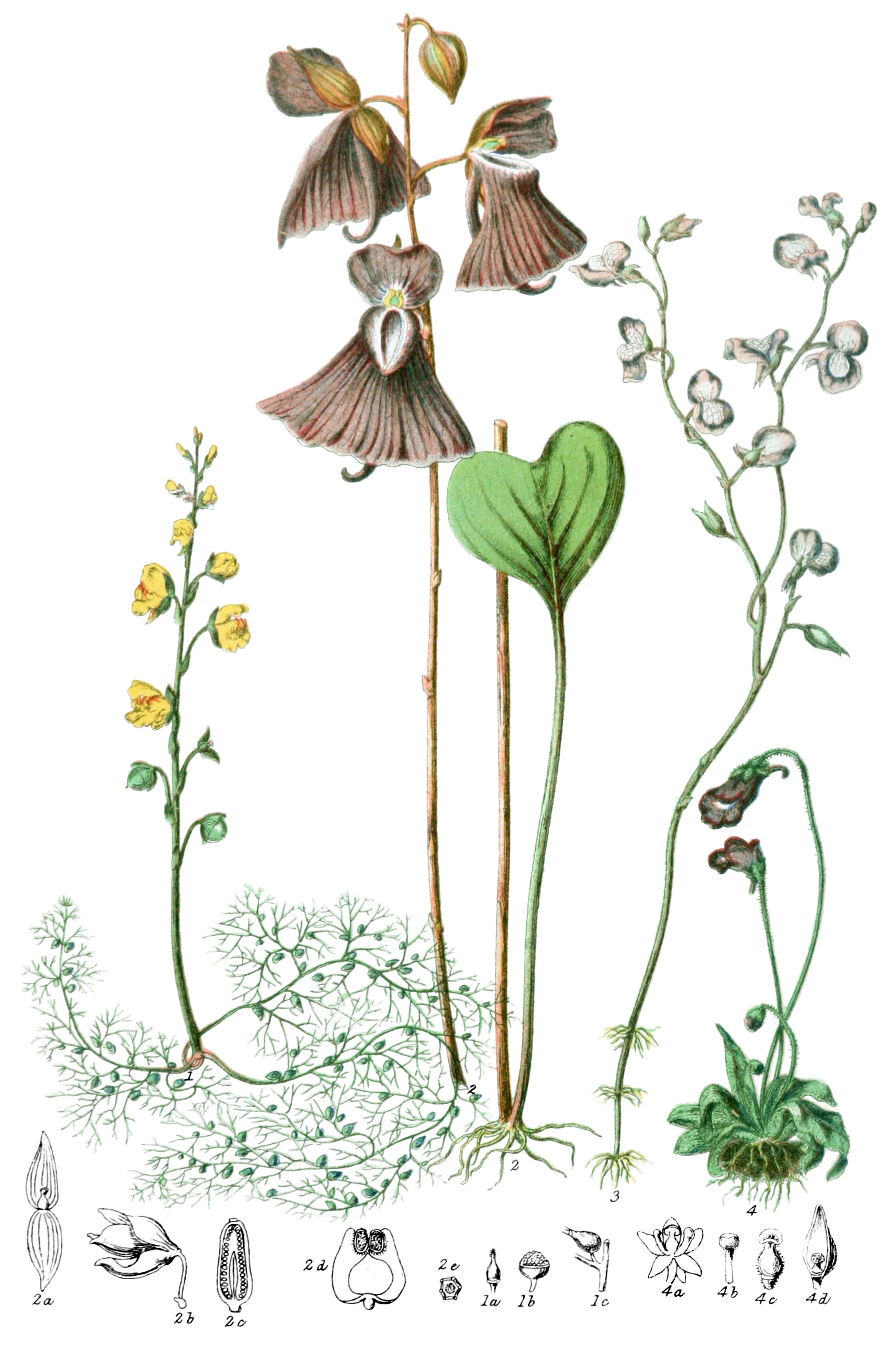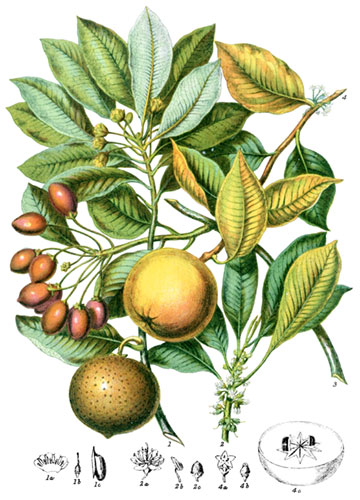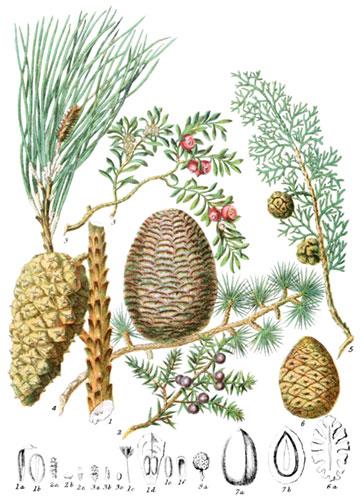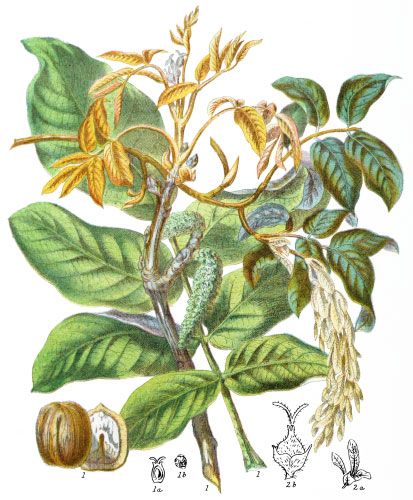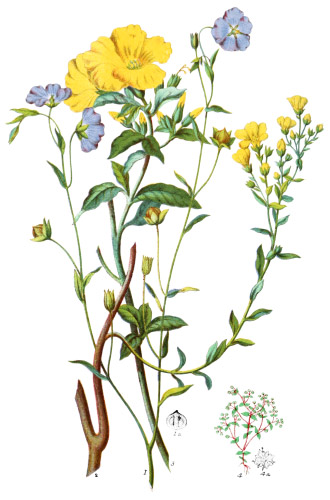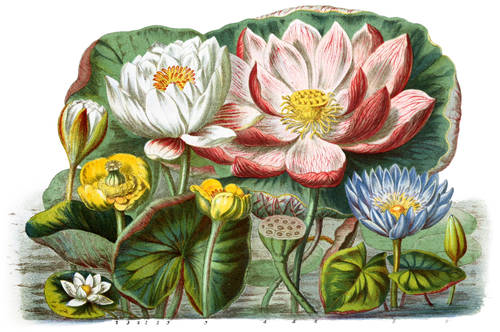Key characteristics
Herbaceous plants in habiting marshes or water. The leaves grow from the top of the root, are either whole or compound, resembling little roots, and bearing small blatters of air or water. The flower-stalk is generally single, seldom branching, and is either naked or clothed with minute scales like stipules, sometimes bearing little vesicles in whorls. The flowers are single or in spikes, or in many-flowered branches, with a single bract, seldom without. The calyx is below the ovary, divided, persistent, partly two-lipped, the upper lip generally three-notched, the lower two-notched. The corolla is of one petal, placed below the ovary, irregular and two-lipped; the lower lip produced into a spur, which is sometimes double. The stamens are two, included within the corolla, and inserted into its base; the anthers are one-celled, sometimes contracted in the middle. The ovary is composed of two carpels, united at the edges, one-celled. The style is single, very short, the stigma bilabiate. The capsule is one-celled, many-seeded, with a large central plate to which the seeds are attached. The sees are minute, without albumen.
These herbaceous plants have most affinity with Scrophulariaceæ, chiefly distinguished by having a one-celled capsule: they are connected with Primulaceæ through Hottonia.
A peculiar property of thickening milk exists in the leaves of Pinguicula.
Select plants in this order
Not all plants listed are illustrated and not all plants illustrated are listed.
- Utricularia is named from utricula, a little bottle, alluding to the vesicles of several species. The plants grow abundantly in the ribulets, lakes, and marshy pools of hot countries; three species are natives of Britain, in different localities; few are known beyond their respective stations, being difficult of cultivation. The flowers are extremely fugacious and delicate, and can scarecely be preserved in a herbal; the brilliant colour of the petals changing to black when pressed and dried; those of the British species are yellow; those of the Tropics and other hot regions are generally blue. The structure of the small bladders is very curious; during the early growth of the plan they are wholly submerged, and contain only water, but when the flowers begin to be developed a change takes place, they rise to the surface, and are found to be filled with air only, small valves closing the orifice. When the seeds are ripening they again sink low. The aquatic species are amply provided with vesicles, and are kept floating by their aid; some which belong to the Tropics are fixed by fibrous roots in the marshes, requiring no other support, and have no vesicles.
- U. vulgaris (1) is our finest species, and may be seen in ditches and deep pools on the south coast; from the finely-divided leaves, as well as form of the flower, it is sometimes called Hooded Milfoil.
- U. Humboldtiana (2) grows in the elevated marshy savannahs of the Roraimé mountains in Guiana, the stem rising to the height of three or four feet, bearing several singularly formed and very elegant purple flowers. This is a remarkable instance of the manner in which an European genus is developed into a more noble type in Tropical regions. It was discovered adorning its native savannahs by Sir Robert Schomburgk, who dedicated it to his learned friend Alexander von Humboldt, but it is one of those fragile ornaments of creation not destined for transportation or dispersion.
- U. reticulata (3) is the native of inundated rice-grounds in the East Indies, twining amongst the rice-stalks, with its round smooth stems and destitute of leaves. The pale netted flower is a curious variety from other species.
- U. montana adorns with its delicate white flowers the sunny meadows around the mountains of the island of Martinique.
- During the late voyage of Mr. Spruce in the Amazon, he found a remarkable species, U. quinqueradiata; the flower-stalks, about two inches long, have an involucre of five rays, spreading horizontally, which floats and supports the plant with its large yellow flower, like a floating lamp. The rays are composed of transparent cells, convex on the surface, forming a kind of chain of vesicles.
- U. uniflora growing on the white sand of the shore is the simplest species yet known; the stem, the size of a sewing-needle, is fixed in the sand by a small cone of roots; it bears no leaves, only a small tubular bract below the simple white flower.
- U. nelumbœfolia is a curious species described by travellers in South America; it makes its habitation in the pools of water accumulated from rain or dew in the hollows of the leaves of a plant of the Pine-apple tribe, probably a Tillandsia, or some allied genus. The roots derive nourishment from the watr entirely, for it is no paraside, and has no connexion with the plant which thus in so singular a way affords it shelder. The roots creep from one leaf to another, and the Utricularia spreads and flourishes.
- Pinguicula inhabits the marshes and bogs of Britain and many othr countries.
- P. vulgaris (4) abounds also in Sweden and Norway, where the leaves are used by the peasants to thicken the milk of reindeer, which is effected without the separation of curd or whey, and is esteemed as a delicacy, the luxuries of food being in those northern countries of a simple nature. The leaves appear to have a certain degree of irritability, bending backwards when the plant is taken out of the ground.
- P. lusitanica is an example of a Portuguese plant migrated to Britain; it grows in Dorsetshire and in the south of Ireland, and has also been found in Scotland.
- This genus is represented in Fuegia by P. antarctica, the chief distinguishing character being a spur much shorter than that of P. lusitanica.
- Genlisea belongs exclusively to Brazil.
Locations
This Tribe inhabits marshes, streams, and still water in all parts of the world; most abundant in the Tropics.
Legend
- Utricularia vulgaris, Greater Bladder-wort. England.
- Pistil.
- Capsule.
- Vesicle, magnified.
- Utricularia Humboldtiana. Savannahs, Guiana.
- Calyx and Ovary.
- Calyx and Capsule.
- Section of Capsule, magnified.
- Stamens.
- Pollen, magnified.
- Utricularia reticulata. Rice-grounds, East Indies.
- Pinguicula vulgaris, Common Butter-wort. England.
- Calyx, Pistil, and Stamens.
- Stamen.
- Pistil.
- Section of Capsule.
Explore more
Posters
Decorate your walls with colorful detailed posters based on Elizabeth Twining’s beautiful two-volume set from 1868.
Puzzles
Challenge yourself or someone else to assemble a puzzle of all 160 botanical illustrations.
